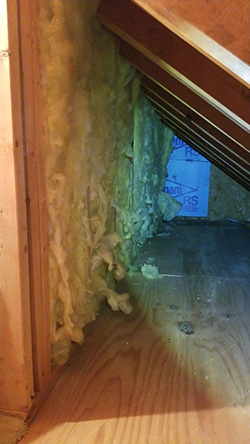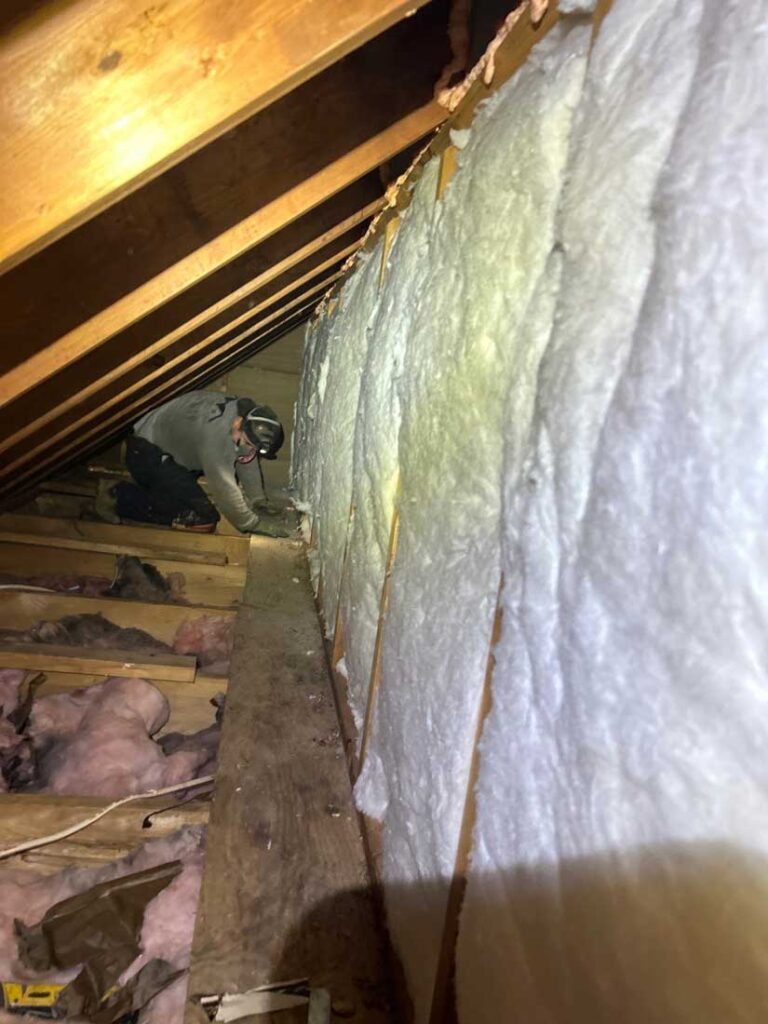“What are knee walls?” you may ask. Knee walls are common in most homes, yet you may not know what they are. A knee wall is a short wall that is approximately two to three feet high and are found in many attics. They’re used to block in the unusable space where the rafters meet the top plates/attic floor, creating more usable attic space.
Go into your attic or simply imagine yourself in the attic. If your attic is unfinished, it has a triangular shape. At the bottom points of the triangles, the rafters meet the top plates of the exterior walls. This is where a knee wall is installed.
The space behind the knee wall is often not insulated or air sealed, and the wall itself doesn’t provide enough thermal barrier to protect the temperature of your attic’s interior.
Insulating knee walls can help protect the temperature of your attic and the interior temperature of your home. Contact us today to learn more about insulating the knee walls of your attic and creating a more energy efficient home.
Benefits of Knee Wall Insulation
Fully insulating your attic is one of the best ways to improve your home’s energy efficiency and cut down on energy bills. More than 70% of energy lost in your home is due to upward airflow, so ensuring your attic is fully insulated and air sealed will help prevent climate controlled air from escaping. That means your home will stay warmer in the winter and cooler in the summer without overworking your heating and air conditioning systems.
Insulating knee walls is a piece of the insulation process that can often be overlooked and lead to unnecessary heat loss. Our experienced insulation professionals at DeVere Insulation Home Performance will identify whether you have a knee wall and ensure it is thoroughly insulated to keep your home protected from the elements.
Knee Wall Insulation Challenges
Insulating knee walls presents unique challenges due to their location and construction. The triangular shape of attics often means that knee walls create awkward spaces that are difficult to access and insulate effectively.
One of the primary challenges with attic knee wall insulation is ensuring proper air sealing. Gaps and cracks in the knee wall area can allow air to leak in and out, compromising the effectiveness of the insulation and reducing energy efficiency. Moreover, the limited space behind knee walls in attic spaces can make it challenging to install traditional insulation materials properly.
Another challenge is determining what is the best insulation for a knee wall. Factors such as cost, R-value, and installation method must be considered to ensure optimal performance and energy savings. Additionally, many homeowners wonder, “Can I insulate my knee wall myself?” The answer is “it’s not recommended”, because it’s often difficult to access and navigate the narrow spaces behind knee walls, making DIY insulation projects impractical or unsafe.


Best Knee Wall Insulation Choices
When insulating knee walls, selecting the right insulation material is crucial for achieving optimal results. Two popular options for knee wall insulation are blown-in fiberglass and spray foam insulation.
Blown-in fiberglass insulation is a cost-effective and versatile option that can be installed quickly and efficiently. It fills gaps and crevices effectively, providing excellent thermal performance when properly installed. It’s also lightweight and doesn’t settle over time, ensuring long-lasting energy efficiency.
Spray foam insulation is another popular choice thanks to its superior insulating properties and ability to air seal. Spray foam expands to fill gaps and cracks, creating a continuous barrier that helps prevent air leakage and heat loss. While it typically has a higher upfront cost than fiberglass, spray foam offers greater energy savings and can pay for itself over time through reduced heating and cooling bills/
Types of Attic Insulation
Whether you’re building a new home with a knee wall or working to upgrade the energy efficiency of an existing home, DeVere Insulation Home Performance in Baltimore can help you determine which type of insulation is best for your attic. We commonly install blown-in fiberglass insulation or spray foam insulation to reach difficult spaces like the area behind knee walls. Air sealing also goes a long way toward cutting down on heat loss and improving your home’s energy efficiency. After inspecting your attic and knee wall, we’ll walk you through the available options and help you determine which type of insulation is right for your home.
Baltimore’s Premier Insulation Contractors
Hiring an experienced home insulation contractor is vital to ensuring your insulation is installed properly and provides your home with the protection it needs. Poorly installed insulation won’t work to its fullest capacity and could mean you’re missing out on energy savings. A professional attic insulation company like DeVere Insulation Home Performance will also help you save money on rebates while making the process as smooth and efficient as possible.
If you’re interested in insulating the knee walls in your attic contact us today for a free estimate!





